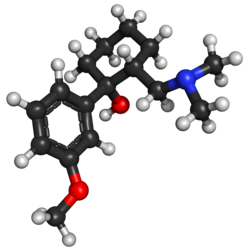User:Mr. Ibrahem/Tramadol
 | |
 | |
| Clinical data | |
|---|---|
| Pronunciation | tra' ma dole |
| Trade names | Ultram, Zytram, others[1] |
| AHFS/Drugs.com | Monograph |
| MedlinePlus | a695011 |
| License data | |
| Pregnancy category |
|
| Dependence liability | Present[3] |
| Routes of administration | By mouth, IV, IM, rectal |
| Drug class | Opiate analgesic[4] |
| Legal status | |
| Legal status |
|
| Pharmacokinetic data | |
| Bioavailability | 70–75% (by mouth), 77% (rectal), 100% (IM)[5] |
| Protein binding | 20%[3] |
| Metabolism | Liver-mediated demethylation and glucuronidation via CYP2D6 & CYP3A4[5][6] |
| Metabolites | O-desmethyltramadol, N-desmethyltramadol |
| Onset of action | Less than 1 hour (by mouth)[3] |
| Elimination half-life | 6.3 ± 1.4 h[6] |
| Duration of action | 6 hours[7] |
| Excretion | Urine (95%)[8] |
| Identifiers | |
| |
| Chemical and physical data | |
| Formula | C16H25NO2 |
| Molar mass | 263.381 g·mol−1 |
| 3D model (JSmol) | |
| Melting point | 180 to 181 °C (356 to 358 °F) |
| |
| |
| | |
Tramadol, sold under the brand name Ultram among others,[1] is an opioid pain medication used to treat moderate to moderately severe pain.[3] It is generally less preferred than other pain medication.[10] When taken by mouth in an immediate-release formulation, the onset of pain relief usually begins within an hour.[3] It is also available by injection.[11] It may be sold in combination with paracetamol (acetaminophen) or as longer-acting formulations.[3][11]
As is typical of opioids, common side effects include constipation, itchiness, and nausea.[3] Serious side effects may include seizures, increased risk of serotonin syndrome, decreased alertness, and drug addiction.[3] A change in dosage may be recommended in those with kidney or liver problems.[3] It is not recommended in those who are at risk of suicide or in those who are pregnant.[3][11] While not recommended in women who are breastfeeding, those who take a single dose should not generally stop breastfeeding.[12] Tramadol is converted in the liver to O-desmethyltramadol (desmetramadol), an opioid with stronger binding to the μ-opioid receptor.[3][13] Tramadol is also a serotonin–norepinephrine reuptake inhibitor (SNRI).[3][14]
Tramadol was patented in 1963 and launched under the name "Tramal" in 1977 by the West German pharmaceutical company Grünenthal GmbH.[14][15] In the mid-1990s, it was approved in the United Kingdom and the United States.[14] It is available as a generic medication and marketed under many brand names worldwide.[3][1] In the United States, the wholesale cost is less than US$0.05 per dose as of 2018.[16] In Canada it costs about 1.20 CAD per dose as of 2021.[10] In 2017, it was the 32nd most commonly prescribed medication in the United States, with more than 21 million prescriptions.[17][18]
References[edit]
- ^ a b c "Tramadol". Drugs.com. Archived from the original on 23 July 2018. Retrieved 22 December 2018.
- ^ a b "Tramadol Use During Pregnancy". Drugs.com. 14 October 2019. Archived from the original on 13 April 2020. Retrieved 7 February 2020.
- ^ a b c d e f g h i j k l m "Tramadol Hydrochloride". The American Society of Health-System Pharmacists. Archived from the original on 12 November 2020. Retrieved Dec 1, 2014.
- ^ "Tramadol". MedlinePlus. American Society of Health-System Pharmacists. 1 September 2008. Archived from the original on 24 September 2009. Retrieved 29 September 2009.
- ^ a b Brayfield, A, ed. (13 December 2013). "Tramadol Hydrochloride". Martindale: The Complete Drug Reference. Pharmaceutical Press. Archived from the original on 29 August 2021. Retrieved 5 April 2014.
- ^ a b "Ultram, Ultram ER (tramadol) dosing, indications, interactions, adverse effects, and more". Medscape Reference. WebMD. Archived from the original on 3 December 2013. Retrieved 28 November 2013.
- ^ Dayer, P; Desmeules, J; Collart, L (1997). "[Pharmacology of tramadol]". Drugs. 53 Suppl 2: 18–24. doi:10.2165/00003495-199700532-00006. PMID 9190321.
- ^ "Australian Label: Tramadol Sandoz 50 mg capsules" (PDF). TGA eBusiness Services. 4 November 2011. Archived from the original on 1 August 2016. Retrieved 6 April 2014.
- ^ "WHOCC - ATC/DDD Index". www.whocc.no. Archived from the original on 25 July 2020. Retrieved 4 September 2020.
- ^ a b "[131] Tramadol: Where do we go from here?". Archived from the original on 16 July 2021. Retrieved 14 September 2021.
- ^ a b c British national formulary : BNF 74 (74 ed.). British Medical Association. 2017. pp. 447–448. ISBN 978-0857112989.
- ^ "Tramadol Pregnancy and Breastfeeding Warnings". Drugs.com. Archived from the original on 13 April 2020. Retrieved 5 September 2016.
- ^ Raffa RB, Buschmann H, Christoph T, Eichenbaum G, Englberger W, Flores CM, Hertrampf T, Kögel B, Schiene K, Straßburger W, Terlinden R, Tzschentke TM (2012). "Mechanistic and functional differentiation of tapentadol and tramadol". Expert Opin Pharmacother. 13 (10): 1437–49. doi:10.1517/14656566.2012.696097. PMID 22698264.
- ^ a b c Leppert W (November–December 2009). "Tramadol as an analgesic for mild to moderate cancer pain" (PDF). Pharmacological Reports. 61 (6): 978–92. doi:10.1016/s1734-1140(09)70159-8. PMID 20081232. Archived (PDF) from the original on 17 October 2016. Retrieved 6 August 2020.
- ^ Fischer, Jnos; Ganellin, C. Robin (2006). Analogue-based Drug Discovery. John Wiley & Sons. p. 528. ISBN 9783527607495. Archived from the original on 6 March 2019. Retrieved 6 August 2020.
- ^ "NADAC as of 2018-12-19". Centers for Medicare and Medicaid Services. Archived from the original on 19 December 2018. Retrieved 22 December 2018.
- ^ "The Top 300 of 2020". ClinCalc. Archived from the original on 18 March 2020. Retrieved 11 April 2020.
- ^ "Tramadol Hydrochloride - Drug Usage Statistics". ClinCalc. 23 December 2019. Archived from the original on 11 April 2020. Retrieved 11 April 2020.
